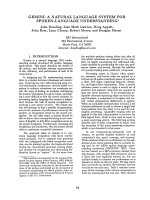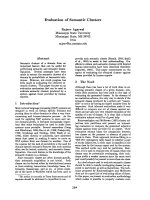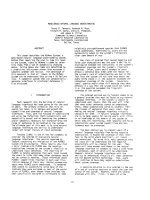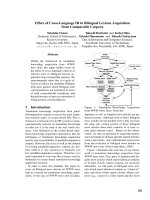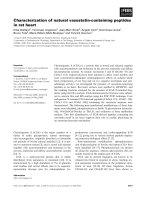Báo cáo khoa học: "EVALUATION OF NATURAL LANGUAGE INTERFACES TO DATA BASE SYSTEMS" pdf
Bạn đang xem bản rút gọn của tài liệu. Xem và tải ngay bản đầy đủ của tài liệu tại đây (360.49 KB, 4 trang )
EVALUATION OF NATURAL LANGUAGE INTERFACES TO DATA BASE SYSTEMS
Bozena Henisz Thompson
California Institute of Technology
INTEODUCT~ON
Is evaluation, like beauty, in the eye
of
the beholder?
The answer is far from simple because it depends on who
is considered to be the proper beholder. Evaluacors may
range from casual users to society as a whole, with sys-
tem
builders, sophisticated users, linguists, grant pro-
viders,
system buyers, and others in between. The
members of thls panel are system builders and linguists
or rather the t~ao fused into one but, I believe,
interested in all or almost all actual or potential
bodies of evaluators. One of our colleagues expressed a
forceful opinion while being a member of a similar panel
at last year's ACL conference: "Those of us on this
panel and other researchers in the field simply don't
have the right to determine whether a system is practi-
cal. Only the users of such a system can make Chat
determination. Only a user can decide whether the hi.
[natural language] capability constitutes sufficient
added value to be deemed practical Only a user can
decide if the system's frequency of inappropriate
response is sufficiently low to be deemed practical.
Only a user can decide whether the overall NL interac-
tion, taken in toto, offers enough benefits over alter-
native formal interactions to be deemed practical" Ill.
It is hard for me co disagree, since I argued as force-
fully on the basis of my study of users* evaluation of
machine translation [2] a study which was prompted by
the evaluations of the quality of machine translation as
viewed by linguists and users, ranging from 35Z accept-
able for the former to 90Z for the latter. Whet the
study also showed was chat the practicality of the out-
put could indeed only be judged by the users, since even
incomplete and stylistically very inelegant translations
were found quite useful in practice because they, on the
one hand, provided, however crudely, the information
sought by the users, and, on the other hand, the users
themselves brought knowledge chat made the texts far
more understandable and useful then might appear co a
nonspecialist linguist. But this endorsement on mY pert
of the user a~ the ultimate judge in evaluations does
not preclude my fully subscribing co Norm Sondheimer's
[3] introductory co~ents co this panel stating that to
"make progress as a field, we need to be able Co evalu-
ate." We are now less likely co confuse the issue of the
evaluation by people like ourselves and the judgment of
the users, less likely to be surprised at the discrepan-
cies,
and less likely to
be
surprised at the users"
acceptance of the limitations of our NL interfaces.
Also, we are far more aware of the fact
chac
evaluations
of '~orth" or "quality" have Co be conducted in the con-
texts of the actual, perceived needs. Zn extensive stu-
dies on evaluation of innovations, Mosteller [4], the
recently retired president
of AAAS,
found that "success-
ful innovators better understand user needs; [and] pay
more attention to marketing " The same source,
however, leads me co the notorious difficulties of
evaluation given the vide range of evaluaCors and their
purposes.
We
are all undoubtedly convinced of the value
of NLI for the society as a whole, but the evaluation of
experiments with these interfaces is another matter.
Mosceller was faced with social, sociomedical, and medi-
cal fields. Let me recount some of the studies he and
his team made for reasons which will soon become obvi-
ous. His teem scored a given program on a scale from
plus ~wo Co minus ~wo with zero meaning there was essen-
tially
uo gain. Accordingly, a study of delinquent
girls that identified th ~- buc failed to prevent them
from delinquency received a zero. Likewise, a zero was
assigned Co a probation experiment for conviction
for public drunkenness in which three methods were
used: (I) no treatment, (2) an alcoholic clinic, and
(3) Alcoholics Anonymous. Since the "no treatment"
group performed somewhat better, short-term referrals
were considered of no value. A minus one was given to a
study whose results were opposite co those hoped for: a
major insurance cOmpany increased outpatient benefits in
the hope of decreasing hospital costs, but the outpa-
tient group's hospital stays increased. Finally, a dou-
ble plus was swarded to an experiment involving the Salk
vaccine, which was, predictably, very successful. Now
this kind of evaluation may be justified when the needs
of the society are at stake. I have gone into these
details, however, for the purpose of expressing the
opinion, in which I know I'm not alone, that nelative
results are as important as positive ones, that evalua-
tion in our case is almost equivalent to the amount of
information obtained in an experiment. An experiment
whose results would be totally predictable would be
almost useless, but one with results different frOm
those hoped for might be embarrassing but very valuable.
Another c~ent prompted by those evaluations is chat
the application of any rigid, fine scale is totally
inappropriate in the case of NLI evaluations.
NLI EVALUATIONS
A.
METHODOLOGY
AND
SOME
RESULTS
It had been widely taken for granted some time ago Chat
l~LI is as good as is its gr-~-r, and a grammar is as
good as it is extensive. The specific needs of users,
the requirements of special tasks and the like cook a
back seat. The nature of ht an discourse was yet to be
explored. Happily, we have been in a different situa-
tion
for some time. When the REL [5, 5, 7] system was
getting into • reasonably sturdy shape with respect to
speed and buss, I started planning experiments to test
it. There yes important literature about discourse,
especially in sociology, such as the work of Schegloff.
It was thus clear that successful NLI experiments had Co
be based on knowledge of hi, an discourse. St was also
clear chat that was the way Co make the interface more
natural. This ass~ption has already been fruitful:
the NL interface in POL [9], a successor Co REL, has
already been extensively improved as a result of the
EEL-related experiments.
Experiments were made in three modes: in addition to
face-to-face and human-to-co~puter, cerainal-co-terminal
communication was examined, since at present chat is the
only practical mode of accessing the computer. Through
early 1980, Over 80 subjects, 80,000 words, and over 50
hours were analyzed in great detail. In the fall of
1980, another 13 subjects were tested in the computa-
tional mode only, adding approximately 20 hours. From
the start, the experiments were encouraging, although
limited to ~wo modes: F-F and T-T. Interactions not
only showed a great deal of structure but extensive
similarities in both modes, the most important being the
constancy of the nt=aber of words in sentences (about
70Z); the length of sentences (about 7 words); the
existence of fragments (70Z of messages in F-F and 50Z
in T-T containing them); and phatics (10Z of total for
F-F and 5Z for T-T). Thus similarities between the
=odes were a candidate for consideration in experiments
in the computational mode, the T-T mode being seemingly
quite far removed from natural F-F. The sentence having
historically been the unit of analysis (and since phat-
its
were considered of lesser Lmportance from the compu-
tational vi~, although of great interest in general),
m 7 attention turned Co fragments. REL allowed for three
non-sentence type structures: "NP?" (including number
parsed into NP); "all/none or uomber" answers; and
39
definitions
introducible by the user which make
ic
pos-
sible to include individual knowledge and terminology.
The
analysis of F-F and T-T protocols, however, showed
the existence of other fragment categories, finally
analyzed ~nco a dozen categories (see [8]). Since they
constitute a considerable amount of F-F conversations
and even T-T protocols, they clearly had co be watched
for in computational experiments.
The experiments for actually observin~ user-system
interaction
were
conducted in the winter Cem
of
1979/80
and produced 21 protocols, the analysis
of
which
was
compared with results of eight F-F and fou~ T-T experi-
ments. Another 13 computational experiments done in the
fall coufimed the results
of
the earlier ones. The
Cask in all three =odes was a real one: loading cargo
onto a ship, the data coming from the actual envirooment
of loading U.S. navy ships
by
a group in San Diego, Cal-
ifornia. In the F-F and T-T
experiments, ~n,~o
persons
were involved
one
given cargo item~ Co
be
loaded, the
other infot~nation about decks (details in [8]). In the
computational mode (H-C) the ship data was in ~he com-
puter
and the list of cargo
to be
loaded was handed Co
the subjects, all with Caltech background. Details
being available elsewhere andspace limited here, only
some major results are given here. Table 1 shows the
comparison of the three modes.
TABLE 1
~-__~ T-__/~
c
Sentence length 6.8
6.I
7.8
Message length 9.5 10.3 7.0
Frequent length 2.7 2.8 2.8
Z
words
in sentences 68.8 72.8
89.3
Z words in fragments 17.2 21.1 10.7
Toca~
AvR.
~ota~
Avt.
ToCa~
Ave,
Messages 5574 697 310 78 1093 52
Parsed & nonparsed 1615 77
Sentences
5302 663 385 77 882 42
Fragments 3253 402 230 58
211 10
Phatics (including
connectors & tags) 48A2 605 148 37 46 2
Total ~ota[ Total
Words in messages 49800 3285 8525
Words in sentences 34266 2393 6880
Words in fra~encs
8584
694 823
As can be seen, several statistics show siailaritias:
sentence length, message length, fragment length, per-
centage
of
words in sentences and fragments.
The close-
ness
of the average of messages in T-T and parsed and
uonparsed inputs in H C is striking.
Table 2 (the meaning of abbreviations is given below the
cable) deals with fragments.
Zt
is mostly
self-
explanatory, as
is the
absence of dsfiniclons from ¥-F
and T-T (although some abbreviations used there fall in
this category) and the absence
of some
other
categories
from T-T and K-C. At
lease
~wo comaents,
however,
are
necessary.
The surprisingly
low
use of terse questions
£n H-C may be accounted for by the tendency toward a
formal style
in compuCacionnl interaction. The defini-
tions used were often of quite complex character,
although far fever than could be hoped for due
apparently to lack of familiarity with this capability.
The complex character of definitions undoubtedly had
some effect on the length of sentences in the H-C mode.
d
TABLE
2
F-F T-T H-C
Tota~
~l TOCa ~
;
TOCa t
g 532 £6.4 10 4.3
ADD 425 13. I 41 17.8
CORE 56 1 • 7
COMP 95 2.9 2 .9
SELF I14 3.5
T~ 571 17.6 67 29.1
TQ 4li
12.5 31
13.4
TI 297 9 . 1 48 20 . 9
FS
413 12.7 23
I0.0
TEUN 339 I0.4 9 3.9
DrY
p
4~2 148
C 1935 34
T 31
91 37 o8
67 27.8
,
30 12,4
53 22.0
Abbreviations
E (Echo): An
ezacc
or partial repetition of usually
the other speaker's string. Often an NP, but it
may be an elliptical structure of various forms.
ADD (Added ~nformatiou): An elliptical structure,
often NP, used to clarif 7 or complete a previous
utterance, often ode" s own, e.g., "IC doesn" ~: say
anything here about weight, or breaking chins,
down. Except for orushablee.", "It's smaller.
36"x20"x17"." Spelling out words was Lncluded
here.
CORE (Correction): This may be done by either speaker.
Tf done
by
the smm speaker it is related Co false
start, but semantic considerations suggest a
correction, e.g., "Those are
30,
,,h,
48
length by
40 width by 14 height."
COMP (ComoleCion): Completion of the other speaker's
utterance, distinguished from interruption by the
cooperative
nature of
the utterance,
e.g., "As T've
got
a
lot of Z've toe
B:
two
pages. A:
Yeah."
SZLY.(Ta~kin S co 0ueself~: Muttsrings, even to the
point of undecipherabiliCy, noc intended for the
other person.
TR
(Terse reply): An elliptical reply, often NP,
e.go, "No.", "Probably meters.", "50 and 7.62."
TQ (Terse OuesCion)
: An
elliptical
question,
often
NP, e.g., '~hy?", "How about pyrotechnics?", '~hich
ones?"
TI (Terse
Information):
A rather elusive category,
neither question, reply nor co and, an elliptical
statement but one often requiring an action.
F8 (False Sta~c): These are also abandoned utter-
ances, but i~edistely followed by usually syntac-
tically and semantically related ones, e.g., "They
may, they may be identical
classes.",
'~ell, the
height, the next largest height I've got is 34."
TRUN (Truncated.): An incomplete utterance, voluntarily
abandoned.
DEF (Definition): E.g., '~0efine: ED:
each deck
of
the
Almeo."
P
(Phatics):
The
largest subgroup
of
fragments whose
nets is borrowed from Malinoweki °s tern "phacic
colmtmion" with which he referred to chose vocal
utterances chat serve to
establish
social
relations
racher than the direct purpose of communication.
This term has been broadened to include all frag-
ments which help keep the channel of communication
open, such as '~ell", '~aic", and even '~ou
Cur-
kay".
Two
subcategories of phacics are:
C (Dialogue Connectors) : Words such as "Then",
"And", "Because" (at
the
beginning of a
message
or
utterance).
T (Tan Ouescions): E.g., "They're all under 60,
seen" t they?"
40
B. SYST~4 PERFORMANCE, sYNTAX USED, SPECIAL STRATEGIES,
AND ERROR ANALYSIS
System performance can obviously be evaluated in a
number of ways, but without good response time meaning-
ful experiments are impossible. When much data is
involved in processing a delay of a few minutes can
probably be tolerated, but the vast majority of requests
should be responded to within seconds. The latter was
the case in my experiments. Fairly complex messages of
about 12 words were responded to in about l0 seconds.
The system clearly has to be reasonably free of bugs
in my case, 12 bugs were hit in the total of 1615 parsed
and nonparsed messages. The adequate extent of natural
language syntax is impossible to determine. Table 3
shows the syntax used by my subjects.
sentences; or possibly just "baby
talk"
due to the
suspicion of the computer's limitations.
An interesting fact to note is that similar results with
respect
to
syntax were obtained in the exper~nents with
USL, the "sister system" of REL developed
by IBM
Heidel-
berg [10] with German used as gLl in two studies of
high school students: predominance of wh-questions (317
in total of 451); not many relative clauses (66); com-
mands (35); conjunctions (26); quantifiers (15); defini-
tions (ii); comparisons (2); yes/no questions (i).
An evaluation which would not include an analysis of
unparsed input would at best be of limited value. It
was shown in Table i that i093 out of 1515 or about ~o
thirds were parsed in my experiments.
TABLE
3
SENTENCE TYPES
Tot~l
882
651
All sentences
Simple sentences, e.g., "List the decks
of
the
Alamo." 73.8
Sentences
with
pronouns, e.g., '~/hat
is
its length?", "what is in its pyro-
technic looker?" 30 3.A
Sentences with quantifier(s), e.g.,
"List the class of each cargo." 71 8.0
Sentences with conjunctions, e.g. "What
is the maxim,
stow
height and bale
cube of the pyrotechnic locker of the
AL?" 88 I0.0
Sentences with quantifier and conjunc-
tion(s), e.g., "List hatch width and
hatch length of each deck of the Alamo." 13 2.6
Sentences with relative clause, e.g.,
"List the ships that have water." 6
.7
Sentences with relative clause (or
related construction) and cemparator,
e.g., "List the ships with a beam less
than
lO00."
6 .7
Sentences with quantifier and relative
clause, e.g., "List height of each
content whose class is class IV." 2 .23
Sentences with quantifier, conjunction
and relative clause, e.g., "List length,
width and height of each content whose
class is a nunicion."
2 .23
Sentences with quantifiers and comparator,
e.g., '~Iow many ships have a beam greater
than
10007'*
3 .34
Wh-questions 75.0
Yes/no questions 1.0
Con=sands
19.0
Statements (data addition) 5.0
Considering the wide range
of R k'r-
syntax [7], the pau-
city of complex sentences is surprising. The use of
definitions which often involved complex constructions
(relative clauses, conjunctions, even quantifiers) had a
definite influence. So did, undoubtedly, the task
situation causing optimization of work methods. The
influence of the specific nature of the task would
require additional studies, but the special device pro-
vided by the system (a loading prompt sequence which
was not analyzed) was employed by every subject. Dew-
ices such as these obviously are a great aid in accom-
plishin 8 tasks. They should be tested extensively to
determine how they can augment the uaturalness of NLIs.
Other reasons for the relatively simple syntax used were
special
strategies: paraphrasing into
simpler syntax
even though a sentence did not parse for other reasons;
"SUCCesS strategy" resulting in repetitious simple
TABLE 4
Total
%
Vocabulary 161 36.1
Punctuation 72 16.1
Syntax 62 13.9
Spelling 61 13.6
Transmission 32 7.2
Definition format 30 6.7
Lack of response 16 3.6
Bus
12
2.7
Table 4 st~_erizes the categories of errors. The
predominance of vocabulary is not surprising, but rela-
tively few syntactic errors are. In part this may be
due to the method of scoring in which errors were
counted only once, so if a sentence contained an unknown
vocabulary item (e.g. "On what decks of the Alamo
cargo be stored?") but would have failed on syatactic
grounds as well, it would fall in the vocabulary
category. A comparison can be made here with Damerau's
study Ill] of the use of the ll~A system by the city
plannin S department in White Plains, at least with
regard to the total of queries to those completed: 788
to 513. So, again, roughly t~ao thirds were parsed. In
other categories "parsin S failure" is 147, "lookup
failures" 119, "nothing in data base" 61, "program
error" 39, but this only points to the general difficul-
ties of comparisons of system performance.
SOME CONCLUSIONS
Norm Sondheimer suggested some questions we might try to
answer. What has been learned about user needs? What
most important linguistic phenomena to allOW for? What
other kinds of interactions? Error analysis points in
the obvious directions of user needs, and so do the
types of sentences employed. While it is justified to
quit the search for an almost perfect grnmm,r, it would
be a mistake to constrain it to the constructions used.
Improved naturalness can be achieved with diagnostics,
definitions, and devices geared to specific tasks such
as special prompting sequences. Some tasks clearly
require math in the NLI. How good are systems? An
objective measurement is probably impossible, but the
percentage of requests processed might give some idea.
In the case of a task situation such as loading cargo
items, the percentage of task completion may signal both
system performance and user satisfaction. System
response times are a very important measure. The ques-
tionnaire method can and has been used (in the case of
MT and USL), but as yet there is too little experience
to measure user satisfaction. Users seem very good at
adapting to systems. They paraphrase, use success stra-
tegy, simplify syntax, use special devices what they
really do is maximize their performance with respect Co
a given task.
41
What have we learned about running evaluations7
It
is
important Co know what to look for, therefore the need
for good knowledge of human to hmnan discourse. Good
system response times are a sine qua non. Controlled
experiments have the advantage of being replicable, a
crucial factor in arriving ac evaluation criteria.
Determining user bias and experience nay be important,
but even more so £s user training. Controlled experi-
ments can show what methods are ~ost effective (e.g. a
manual or study of proCocols~). Study of
user
commence
phacic material gives some measure of user
(dis)satisfaction (I have seen '"/ou lie," buc I have yeC
to see "Good boy, youZ"). Clearly, the best indication
of user satisfaction is whether he or she uses the sys-
tem again. Extensive IonS-term studies are needed for
that.
What should the future look like? Task oriented situa-
tions seem to be a promising envirooment for ~LZ. The
standards of NL systems performance will be set by the
users. Future evaluations? As Antoine de Sainc-Zxup&r7
wrote, "As for the Future, your task is not to foresee,
but to enable
it."
REFERENCES
i. Harris, Larry E. "Prospects of Practical Natural
Language Systems." Proceedings of the 18th Annual
Meetin~
of
the Association
for
Computationa~
Linguistics, June 1980, p. 129.
Z
Henisz-DosterC, B.; Macdonald,
R.
E.; and Zarech-
rusk, M. Machine Translation. The Hague: Mouton,
1979.
3. Sondheimer, N. K. "Evaluation of Natural Language
Interfaces to Data Base Systems." Proceedings o(
the 19th Annual Meecin~ of the Association for Com-
putational Linguistics, June 1981.
4. Mosteller, F. "~nnovation and Evaluation." Science
(February 27, 1981):881-886.
5. Thompson, F. B. and Thompson, Boaena H. "?tactical
Natural Language Processing: The EEL System as
Prototype." In Advances in Computers, ed. M. Rubi-
noff and M. C. Yovits. Yol. 13. New York:
Academic Press, 1975.
6.
Thompson, BozenaH. and Thompson, F. B. "Rapidly
Extendable Natural Language." Proceedings of the
1978 Nationa~ Conference of the ACM, pp. 173-182.
7. Thompson, Bozena H. REL English for the User.
Pasadena: California Institute of Technology, 1978.
8. Thompson, Bozena H. "Linguistic Analysis of
Natural Language Co ,unication rich Computers."
COLING 80: Proceedings of the gCh Internationa~
Conference on Computariona~ Linguistics, Tokyo,
October 1980, pp. 190-201.
9.
Thompson, Bozeua H. and Thompson, F.B.
"Shifting
to a Higher Gear in a Hatural Language System."
Proceedinzs of the Nat~ona~ Computer Conference,
May 1981.
10. Lehmann, Hubert; OCt, Nikolaue; Zoeppri~z, Mag-
dalene. '~ser Experiments with Natural Language
for DaCe Base Access." COLING 78: ProceedinRs of
ch~
7oh
International Conference on Computational
Linguistics. Bergen, August
1978.
Ii. Oamtrau, Fred
J.
The Transformational ~uestion
Answ~rin~ ~T~A~ System: Operational Statistics -
1978. EC 7739. Yorktown Heights: IBM T. J. Watson
research Center,
June
1979.
42

